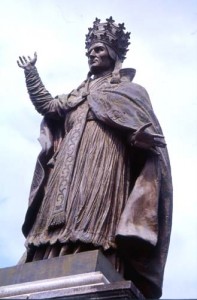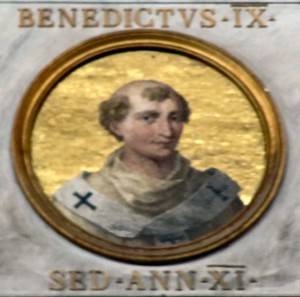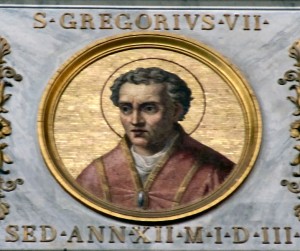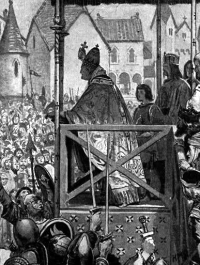Evaluating the Tusculan popes and the reformers who succeeded them. Continue reading
Almost no one has even heard of Pope Benedict X. Pope Stephen IX had died in Florence on March 29, 1058. On April 4 a group of bishops met in Rome and elected John, the Cardinal-Bishop of Velletri, as the new pontiff. At the time there were no set rules for the selection of a new pope. The designation of the College of Cardinals as the body charged with papal elections did not come until later (although not much later). Benedict’s election was pretty much in line with established procedure at the time. The elections that were quite different from it were generally far less canonical. For example, Stephen’s three predecessors were all hand-picked by Emperor Henry III and rubber-stamped by councils sometimes held as far away from Rome as the German city of Worms. Furthermore, John was a rising star in the curia and was widely considered as being on the short list of papabili.
Benedict’s pontificate, however, had a few fatal flaws. In the first place he was a relative of the counts of Tusculum who had controlled the papacy for most of the eleventh century. The second was that the most influential figure in the so-called reform party, a young monk named Hildebrand, was in Germany at the time negotiating with Henry III’s widow, Agnes, who was the regent for her seven-year-old son. Allegedly Pope Stephen IX had asked that the election of his successor be postponed until Cardinal-Deacon Hildebrand could return.
Hildebrand did return, but he did not exactly rush back. Pope Benedict ruled until January of the following year. Not much is known about his pontificate, which is a pretty clear indication that it was a period of peace and relative tranquility. The same, by the way can be said of the pontificates of the other three Tusculan popes of the eleventh century. All told, these four men ruled Rome, the papal territories, and the Christian Church for about thirty-five years.
The cardinals met in Florence and on January 23, 1059, elected a man named Gerard from the Provence area of France. Hildebrand had arranged for Godfrey, the Duke of Lorraine, who was by far the most powerful man in Italy because of his marriage to Beatrice, the widow of the Margrave of Tuscany, to accompany them to Rome. Since Godfrey brought most of his army with him, Benedict was forced to flee, and Gerard was installed as Nicholas II. His first six months were largely devoted to employing Godfrey’s troops and some Normans who had been commissioned by Pope Stephen to hunt down Pope Benedict and his Tusculan supporters. A series of bloody battles ensued. Benedict fled first to a castle near Tivoli and then to the castle of the Count of Galeria, which was north of Rome. Eventually he was apparently captured, but accounts differ greatly as to what became of him after that.
Hildebrand also eventually was elected pontiff. He was known as Pope Gregory VII from 1073-1085.
There is no question that the reformers won a total victory over the influential noble families that had controlled the papacy in the early eleventh century. Reading the official records one can easily to picture them as a group of progressives who loved the Church so much that they felt obligated to do whatever was required to eliminate the corruption that had infested the papacy. In fact, Hildebrand and one other reform pope, Leo IX, are both canonized saints. Since only seven popes in the second millennium achieved that distinction (and two of those were named in the last year), this is quite unusual. For all that I know the two of them are sitting at God’s right and left hands (assuming that He has hands and that there are only two of them). I do know, however, that it is hard to think of any popes who were less successful than these two.
Leo, like the other German popes, spent almost no time in Rome. A cousin of Emperor Henry III, he almost immediately turned his attention to the Normans who controlled large swaths of southern Italy. The pontiff went to Germany and tried without successful to persuade the emperor to provide him with an army. He then hired a band of Swabian freebooters and led them back to Italy. After he combined this force with part of Godfrey’s contingent, he marched into Apulia, where he confronted the Normans and provoked them into the Battle of Civitate. When the dust settled, the papal forces had been routed, and the pope himself was in Norman hands. Although he was treated with respect and allowed to communicate freely with his subordinates, Pope Leo was held in Benevento almost until his death.
During his captivity Pope Leo dispatched some envoys to Constantinople to confront the patriarch. They came armed with forged documents that claimed that six centuries earlier the Emperor Constantine had bequeathed all of western Europe to St. Peter, whose vicar on earth was the Bishop of Rome. The westerners may have considered the documents to be genuine, but the story they told contradicted many events that were well documented in the east. When the patriarch refused to meet with them, the pope’s legates left a decree of excommunication on the high altar of the Hagia Sophia. This reckless act began the Great Schism between the Roman Church and the Greek Orthodox Church and its affiliates, which has lasted until this day.
So, Leo had two great legacies. He spent most of his time gathering together a Christian army that he used to attack a different Christian army. This one resulted in a lot of deaths and his own capture. The other was a committee armed with bogus documents that split the Christian Church in two irreparable (at least so far) pieces.
Gregory VII’s claim to fame was his attempt to wrest from Emperor Henry IV (a young man by this time) the power to invest bishops in imperial holdings. When the emperor refused, Gregory excommunicated him. The emperor, who was facing opposition in Germany, eventually repented and came to Gregory to ask for the lifting of the excommunication. For three long winter days he stood outside in the cold waiting for the pontiff to make up his mind. Eventually Gregory reinstated him.
Henry had to return to deal with a civil war in which the pope supported his opponent, Rudolph. When it appeared that Rudolph was winning, the pontiff again excommunicated Henry. The tide turned, however, and Henry not only solidified his hold in Germany. He also marched back into Italy and called a council that elected a new pope named Guibert. For a time there was a stalemate between Gregory’s forces and those of Henry/Guibert. Finally, in a desperate move Pope Gregory asked Robert Guiscard, the leader of the Normans to liberate him. He did, but the Normans also sacked Rome, inflicting much more damage than either the Goths or the Vandals had inflicted.
Gregory became a persona non grata in Rome. He spent the rest of his pontificate wandering as a beggar in southern Italy. His two hand-picked successors also had great difficulty even entering the city.
Here are a couple of questions that Church historians seldom ask. 1. Who were these “reformers”? 2. What did they want?
The answer to #1 is that almost all of them were Benedictine monks. The answer to #2 is a little trickier. Their platform included the elimination of simony (purchasing of religious offices) and the enforcement of celibacy among the clergy in the Church. By Hildebrand’s time they also championed the elimination of investiture by civil rulers like Henry IV. They have been almost uniformly portrayed as righteous people who took a corrupt papacy and returned it to the principles of the gospels. The word “portrayed” here is key. Almost everything known about these people was written by them and their supporters.
There is a different way to look at it. Before the reformers took over, the papacy was a local affair. The popes were generally elected by groups of local bishops. It is probably true that sometimes one noble family or another would spread enough cash around to influence the election. Outsiders would, however, only be called upon to help in dire circumstances when the very life of the papal states and the pope were in jeopardy. Seldom did any pope attempt to exert much influence outside of the papal states. Other regions chose their own bishops. There were no general rules for doing so. The popes seldom left their own territories.
The sex lives of clergymen was not high on the priority list of any of the Tusculan pontiffs. Pope Benedict IX, the third of the Tusculan pontiffs, was charged with many outrageous acts of sexual misconduct. His primary accuser was Peter Damian, the chief propagandist of the reformers, a man who never set foot anywhere near Rome during the time when Benedict IX was supposedly misbehaving.
Ethics aside, the reformers transformed the papacy in two ways. Their primary focus was the attempt to make the pope, once they controlled who wore the tiara, a prominent player on the European and, eventually, the world stage. Pope Urban II, who called the First Crusade, was a disciple of Hildebrand’s. In this they had mixed results. The First Crusade, although it caused the loss of hundreds of thousands of Christian lives, did result in the capture of Jerusalem. The other crusades – and there were many – were, by just about any measure, disasters.
They were much more successful in the other aspect, which was to change the rules so that they had access to power. In fact, the monks exerted dominance over papal elections long after the original purposes of the reformers were dim memories.
The question no one seems to ask is this: What did the Christians in Rome think? If I were a Roman, I would certainly have preferred the relative calm of the Tusculan pontiffs to the chaos and catastrophes of the reformers.
Two men, Boniface VII and Benedict X, were elected as pope and served as the unquestioned leader of the Church for a considerable period of time. Everyone considered them the pope. Both fled when threatened. In both cases the next pontiff who took the name (centuries later) assigned himself a number that was one more than the neglected pope.
Neither Boniface nor Benedict is on the official list of popes, and, take my word for it, there are dozens of popes with flimsier claims. All that it proves is that history is written by the winners.





